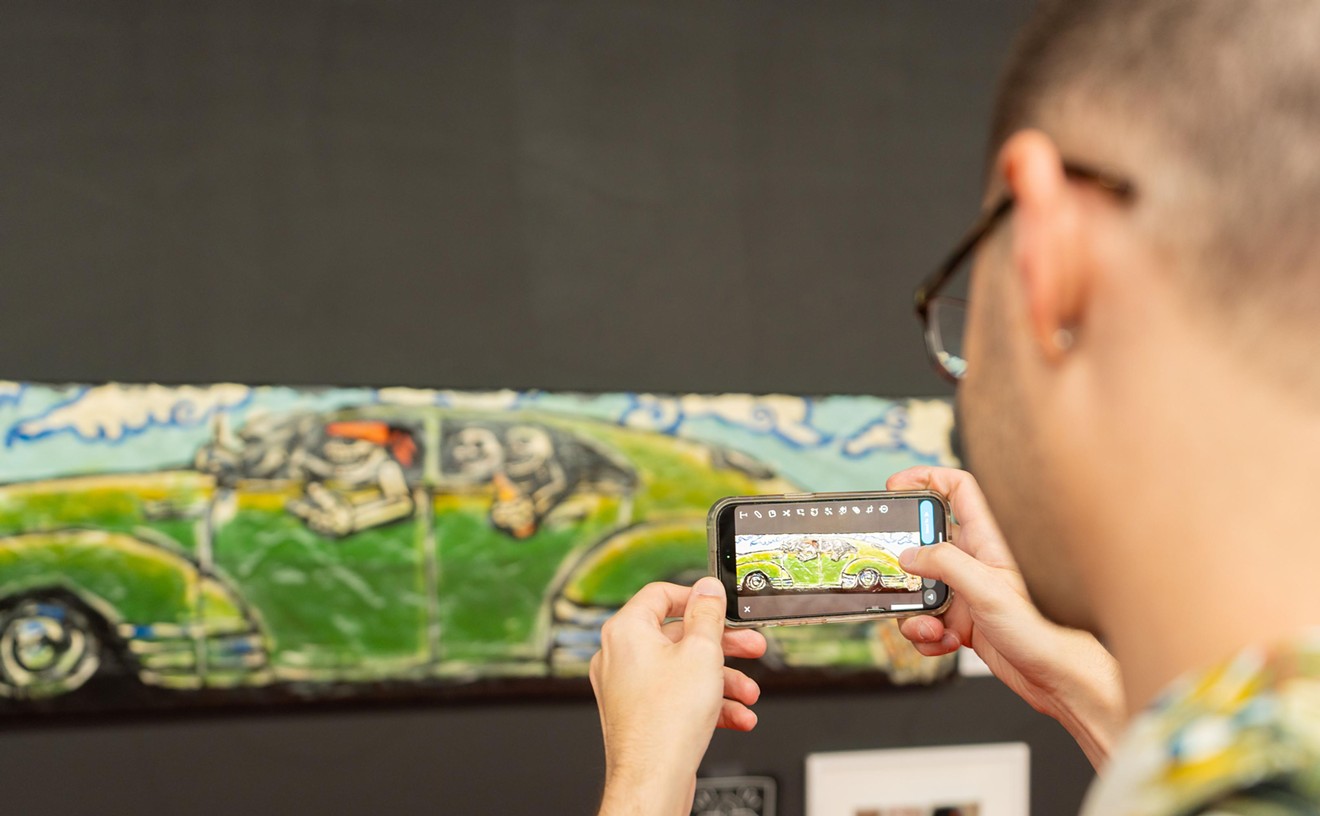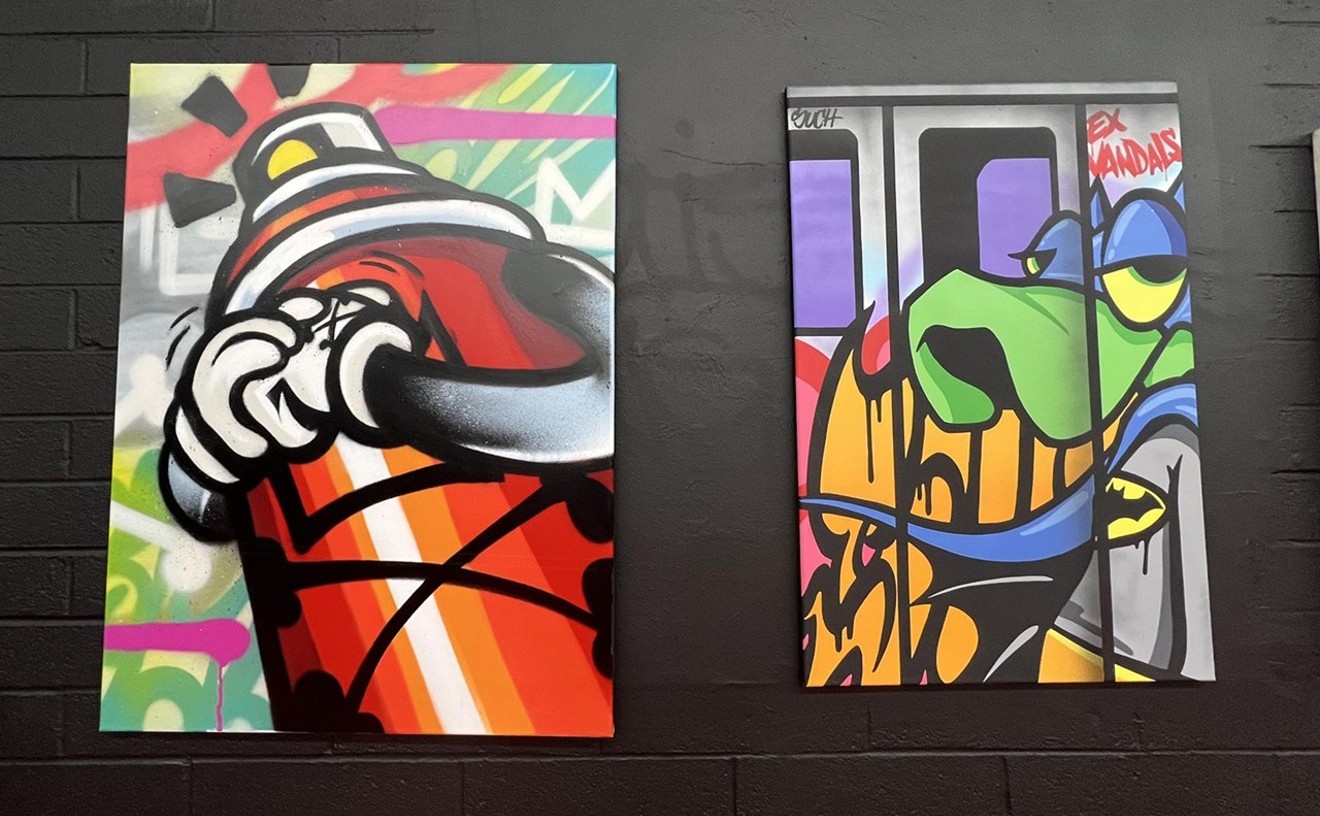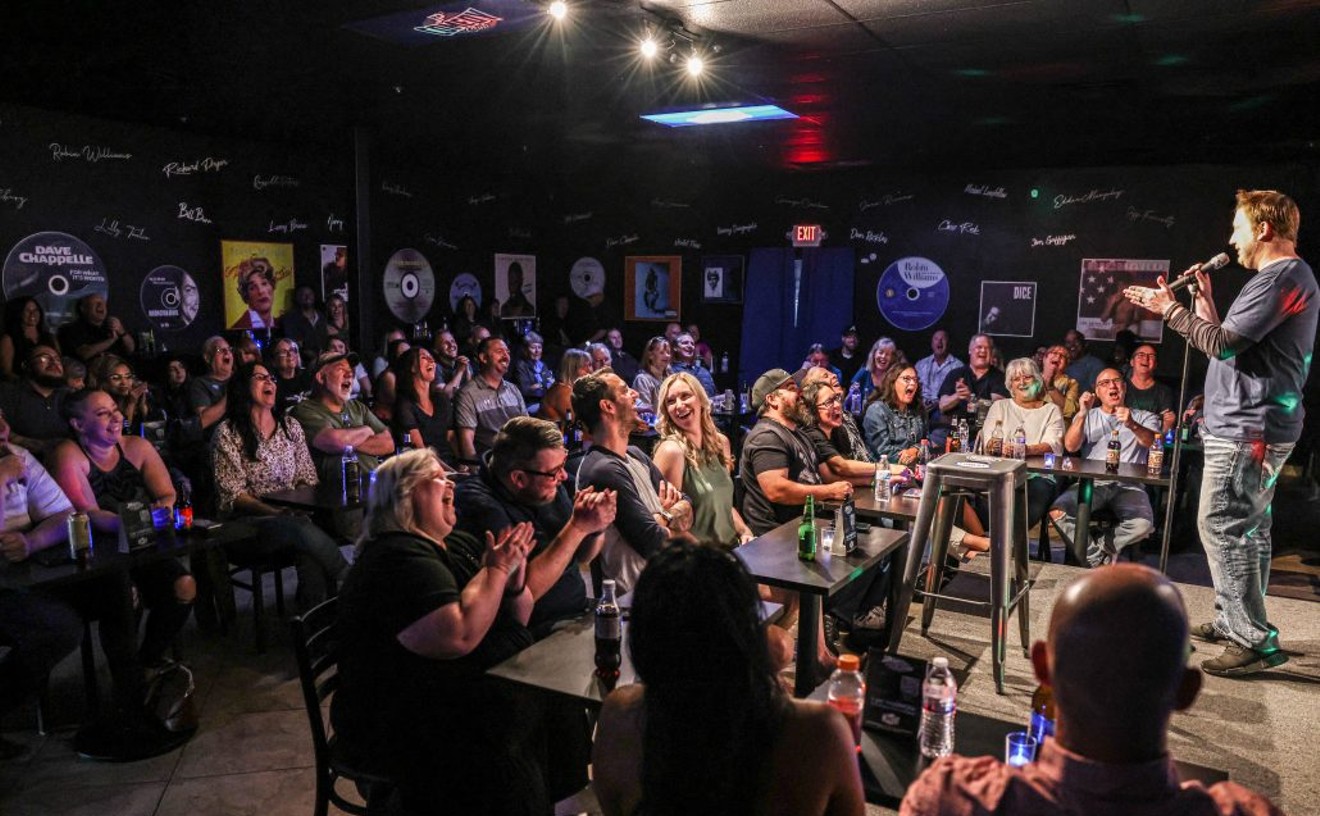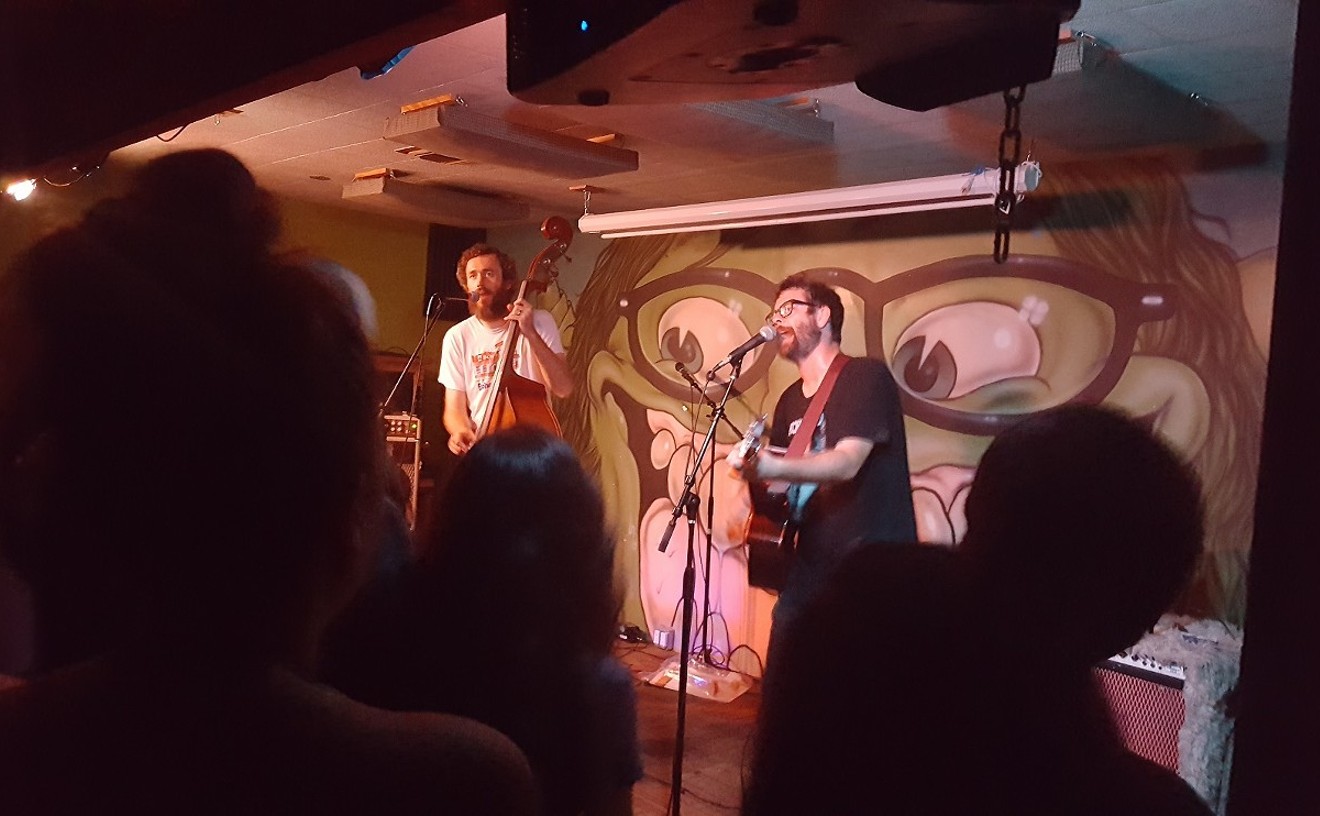Surveillance. Militarization. Vigilantism. A trio of interdisciplinary artists known collectively as Postcommodity has seen it all during eight years working along the U.S.-Mexico border. The tangible fruits of their labor — a work of land art created with community members in Douglas, Arizona, and Agua Prieta, Sonora — will be on view from Friday, October 9, to Monday, October 12.
Editor's note: Due to weather delays, the installation will go up the morning of Saturday, October 10.
Titled Repellent Fence, the work comprises 26 tethered “scare eye” balloons, each 10 feet in diameter, floating 50 feet above the desert landscape to create a two-mile-long sculpture intersecting the border. It’s conceived as “a bi-national suture, stitching the land and communities back together for a moment in time” while demonstrating the interconnectedness of peoples and cultures.
The balloons they’re using are readily available, often sold to people trying to scare unwanted birds from their backyards. Postcommodity artists Raven Chacon, Cristóbal Martinez, and Kade L. Twist first learned of the balloons after Martinez’s wife ordered one online in the hopes of deterring doves from visiting their Tempe backyard.
Postcommodity describes these balloons as both consumer objects and art objects, noting that they bear indigenous medicine colors of the Western hemisphere: yellow, black, red, and white. And they see an additional indigenous connection — the use of oblong concentric circles reflecting “open eye” iconography used for thousands of years by indigenous peoples from Canada to South America.
Early on, they conceptualized using the balloons to create a temporary monument meant to mock the absurdity of contemporary approaches to the border and immigration. President George W. Bush had gotten approval to build a wall along the border, they recall. And Arizona was grappling with SB1070, a piece of legislation that required state agencies and officials to assist with enforcement of federal immigration laws. But the conceptual framework for Repellent Fence evolved over time as they developed “personal and community relationships” along the border.
The balloons will be raised into the air on Friday, October 9, by Postcommodity together with community members in Douglas and Agua Prieta. Postcommodity describes this location as “the center point of the largest and most densely fortified militarized zone” in the Western hemisphere. The artists chose this region after a “roughly six years search,” during which they traveled between various communities from California to New Mexico encountering both the harsh desert landscape and “the brutal reach of the drug cartels.”
They’ve spent the past two-plus years engaging a diverse array of stakeholders in the project, crediting artists, ranchers, entrepreneurs, religious leaders, and many others with “co-determining” the work's final form, location, and meaning. Along the way, those community members have developed their own conversations and projects. “What we leave behind are relationships mobilized through arts and culture,” Twist says. “There’s already a movement in both communities for a greater presence for the arts in everyday life.”
It’s evident in the creation of bi-national art walks, one of which takes place the during the afternoon and evening on Saturday, October 10. “When they saw us try and do something ambitious, it inspired them to do something ambitious,” Twist says. “The biggest thing artists have is the role of the catalyst.”
“We’re not protesting or advocating for any solution,” Chacon adds. “We’re just doing storytelling.” Hence, Chacon describes Repellent Fence as “a narrative mechanism” rather than a work of social justice art. Twist describes it as “a land art piece and social engagement piece.”
Both Repellent Fence and the community engagement that fueled its development reflect the artist collective’s unique practice — which serves as “a shared indigenous lens and voice.” Their goals include getting the public to acknowledge indigenous people.
They chose the collaborative model for both pragmatic and philosophical reasons — including a shared desire to create work in which “the whole is greater than the individual parts.” Twist notes that collaboration allows them to better leverage resources of dollars, time and manpower, as well as work on larger-scale projects. He describes their trio as a “community of learning” in which the artists teach one another and share different skill sets.
Rather than a shared Postcommodity studio, each artist has his own studio space. Martinez is based in the Phoenix area, where he’s lived for two decades. Twist moved two years ago from Phoenix to Sante Fe, and Chacon is based in Albuquerque. Martinez is quick to note “how important the Phoenix art community has been” — citing the generosity of the city’s artists with both their time and money. Previous Postcommodity collaborators include Phoenix artist Steve Yazzie.
The collective has also exhibited its work in metro Phoenix. Early in 2015, two Postcommodity installations were featured at Scottsdale Museum of Contemporary Art.
Public events for Repellent Fence include the community installation at sunrise on Friday, October 9, and the opening reception at 7 p.m. that evening. The Agua Prieta Fiesta/Douglas Fiesta takes place Saturday, October 10, from 11 a.m. to 2 p.m. Several walking tours are scheduled as well.
Arizona Commission on the Arts, which is not part of presenting or funding Repellent Fence, launches its new AZ ArtWorker professional development program the same weekend with three events taking place in Douglas:
• Public conversation with Postcommodity, nationally-renowned artist Ana Teresa Fernández, and Douglas artist Jenea Sanchez, which takes place Saturday, October 10, at 7 p.m. The event is presented in partnership with ASU Performance in the Borderlands.
• Artist training with Fernández and Sanchez on the creation of site-specific artworks through interactive projects, which takes place Sunday, October 11, from 10 a.m. to noon.
• The Crossing: A Public Intervention on the Fence, which was scheduled to take place on Saturday, October 10 at 5 p.m., has been canceled.
Postcommodity hopes the Repellent Fence project will facilitate public dialogue, infuse indigeneity into discussions of immigration and borderlands, and complicate colonial frameworks for bi-national discourse.
But they’re not stopping there. They’re working on an interactive game — described by Martinez as “something between playing a video game and playing a musical instrument” — that will serve to promote the value of systems tied to listening as well as speaking. And they’re already working with ASU Art Museum Curator Julio Cesar Morales on an exhibition scheduled to open at the museum in 2017.
Find more information about Postcommodity, the Repellent Fence, and related events on the Postcommodity website.
Editor's note: This post has been updated to note that The Crossing: A Public Intervention on the Fence has been canceled.
[
{
"name": "Air - MediumRectangle - Inline Content - Mobile Display Size",
"component": "18478561",
"insertPoint": "2",
"requiredCountToDisplay": "2"
},{
"name": "Editor Picks",
"component": "16759093",
"insertPoint": "4",
"requiredCountToDisplay": "1"
},{
"name": "Inline Links",
"component": "17980324",
"insertPoint": "8th",
"startingPoint": 8,
"requiredCountToDisplay": "7",
"maxInsertions": 25
},{
"name": "Air - MediumRectangle - Combo - Inline Content",
"component": "16759092",
"insertPoint": "8th",
"startingPoint": 8,
"requiredCountToDisplay": "7",
"maxInsertions": 25
},{
"name": "Inline Links",
"component": "17980324",
"insertPoint": "8th",
"startingPoint": 12,
"requiredCountToDisplay": "11",
"maxInsertions": 24
},{
"name": "Air - Leaderboard Tower - Combo - Inline Content",
"component": "16759094",
"insertPoint": "8th",
"startingPoint": 12,
"requiredCountToDisplay": "11",
"maxInsertions": 24
}
]











